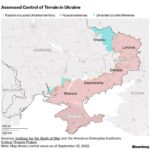
WASHINGTON — President Vladimir Putin of Russia has thrust himself more directly into strategic planning for the war in Ukraine in recent weeks, American officials said, including rejecting requests from his commanders on the ground that they be allowed to retreat from the vital southern city of Kherson.
A withdrawal from Kherson would allow the Russian military to pull back across the Dnieper River in an orderly way, preserving its equipment and saving the lives of soldiers.
But such a retreat would be another humiliating public acknowledgment of Putin’s failure in the war and would hand a second major victory to Ukraine in one month. Kherson was the first major city to fall to the Russians in the initial invasion and remains the only regional capital under Moscow’s control. Retaking it would be a major accomplishment for President Volodymyr Zelenskyy of Ukraine.
Sign up for The Morning newsletter from the New York Times
Focused on victory at all costs, Putin has become a more public face of the war as the Russian military appears increasingly in turmoil, forcing him to announce a call-up this week that could sweep 300,000 Russian civilians into military service. This month, Moscow has demonstrated it has too few troops to continue its offensive, suffers from shortages of high-tech precision weaponry and has been unable to gain dominance of Ukraine’s skies.
But American officials briefed on highly sensitive intelligence said that behind the scenes Putin is taking on an even deeper role in the war, including telling commanders that strategic decisions in the field are his to make. Although Putin has accepted some recommendations from military commanders, including the mobilization of civilians, his involvement has created tensions, American officials said.
The officials said that Putin’s rejection of a military pullback from Kherson has also led to a decrease in morale among Russian troops who have been mostly cut off from their supply lines and who appear to believe they could be left stranded against Ukrainian forces.
“The situation in Ukraine is clearly dynamic,” Gen. Mark Milley, chair of the Joint Chiefs of Staff, said in an interview Friday. “It’s too early for a full assessment, but it is clear to me that the strategic initiative has shifted to the Ukrainians.” But he cautioned that there remains a “long road ahead.”
Putin’s disagreements over battle lines in Kherson illustrate how critical the war in Ukraine’s south is to both sides, American officials said. Despite Ukraine’s recent advances in the northeast, the area around Kherson is a critical theater in the war, with profound strategic implications for Kyiv and Moscow.
Some American officials said they saw trouble ahead for the Russian military in the southern theater. A senior U.S. official said this week that Ukraine was well on its way to repeating in the south the gains its forces had managed during a lightning offensive in the northeast earlier this month. If Ukraine pushes Russian forces back farther, Putin’s hard-fought-for land bridge to Crimea, the territory it captured from Ukraine and annexed in 2014, could eventually be threatened, American officials said.
The divisions over Kherson are only the latest disagreements between Putin and his top commanders. Senior Russian officers repeatedly questioned the early plans for the war, American officials said, particularly an initial stage that envisioned a quick strike on Kyiv, the Ukrainian capital. The Russian officers believed Putin was going to war with insufficient troops and weaponry, American officials said.
The Russian officers’ concerns proved correct, and after the defeat of the Russian army outside Kyiv, Putin eased up his control of military planning. He allowed senior generals to create a new strategy focused on massive artillery barrages, American officials said. The new strategy was effectively a grinding war of attrition that played to the Russian military’s strength and succeeded in pushing the army forward in eastern Ukraine.
Since Putin ordered his commanders to continue fighting in Kherson, the Russian military has tried to halt the Ukrainian advance there. Last week the Russians blew up a dam on the Inhulets River to make the current counteroffensive more difficult.
But Ukrainian strikes have blown up the crossings over the Dnieper River, which has largely cut off Russian troops from their supply lines on the other side. Russians have had to use pontoon bridges to cross the river, only to see them hit by Ukrainian fire, Ukrainian officials said. “They’ve got units in there who, if the Ukrainians break through the lines, will be cut off and surrounded,” said Seth G. Jones, senior vice president at the Center for Strategic and International Studies. “I cannot overstate how dicey the situation is for them.”
Pulling back past the Dnieper River would likely allow Russian commanders to hold the line in the south with fewer troops. That would give them more latitude to redeploy forces from Kherson to other areas, either pushing back against the Kharkiv counteroffensive in the northeast, solidifying defensive lines in the eastern Donbas region or opening up a new front in the south.
But Putin has told commanders he will set the strategy.
“In this war there has been a consistent mismatch between Putin’s political objectives and the military means to attain them,” said Michael Kofman, director of Russia studies at CNA, a defense research institute in Arlington, Virginia. “At important decision points Putin has procrastinated, refusing to recognize the reality, until the options turned from bad to worse.”
Pulling Russian forces back past the Dnieper River would also be a stark rebuttal to Putin’s referendum there on joining the Russian Federation. Holding such sham votes is a key objective of Moscow. Blocking them remains one of Kyiv’s top priorities.
With dissent rising in Russia, and military-age men attempting to flee the country to avoid the call-up, American officials say Putin believes another Ukrainian victory would further erode the popularity of the war, something he cannot risk. Videos widely shared on Twitter in the days since Putin announced his call-up show angry draftees being scolded by shouting Russian military officials. “Playtime’s over!” yells one military official in one video. “You’re soldiers now!”
Putin’s conversations with his regional military commanders in Ukraine may also be part of an effort to get more accurate assessments of the campaign. As the war has gone on, American officials have said that Putin has not been given accurate information from his top military advisers: Sergei K. Shoigu, the defense minister, and Valery Gerasimov, the Russian military’s chief of the general staff.
In addition to blocking a retreat from Kherson, Putin has raised doubts about Russian efforts to consolidate their position in the northeast near the Oskil River, which the Ukrainian counteroffensive reached this month. Putin, an American official said, has opposed pulling back there as well, because he is reluctant to hand anything to Zelenskyy that looks like a win.
Even as Putin demands a strategy of no further retreats, American officials said Russian officers are divided on how to respond to the Ukrainian counteroffensives. Some officers believe they should push back hard on Putin’s directives before the Ukrainians break through their current lines. Others believe they can follow through on Putin’s directives.
Russia has continued to focus on the south, despite Ukrainian progress east of Kharkiv. While Moscow has sent some reinforcements to embattled northeastern positions, most of the tens of thousands of troops whom Russia sent south to the Kherson area — including some of its best combat forces — remain in place.
© 2022 The New York Times Company




